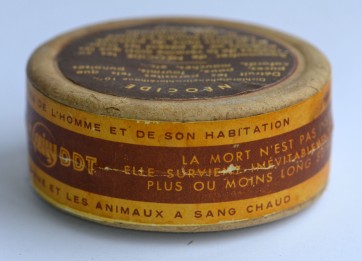Bedbug resistance to poison
DDT Ban
The cancellation decision culminated three years of intensive governmental inquiries into the uses of DDT. As a result of this examination convinced the Environmental Protection Agency that the continued massive use of DDT posed unacceptable risks to the environment and potential harm to human health.
The ban was attributed to a number of factors including increased insect resistance, development of more effective alternative pesticides, growing public and user concern over adverse environmental side effects–and governmental restriction on DDT use since 1969.
http://www.epa.gov/history/topics/ddt/01.html
 DDT
DDT
In 1962, Silent Spring by American biologist Rachel Carsonwas published. The book catalogued the environmental impacts of the indiscriminate spraying of DDT in the US and questioned the logic of releasing large amounts of chemicals into the environment without fully understanding their effects on ecology or human health. The book suggested that DDT and other pesticides may cause cancer and that their agricultural use was a threat to wildlife, particularly birds. Its publication was one of the signature events in the birth of the environmental movement, and resulted in a large public outcry that eventually led to DDT being banned in the US in 1972. DDT was subsequently banned for agricultural use worldwide under theStockholm Convention, but its limited use in disease vectorcontrol continues to this day and remains controversial.
http://en.wikipedia.org/wiki/DDT
+++++++++++++++++++++++++++++++++++++++++++++++++
Pyrethroid
Bedbugs have been a problem for humans for thousands of years. Up until the 1950s, they were almost completely wiped out due to the use of DDT. After the use of DDT for this purpose was banned, pyrethroids became more commonly used against bed bugs. As of 2010 nearly all populations of bedbugs have evolved nerve cells impervious to pyrethroids, and pyrethroids are no longer effective in combatting bedbug infestations.
http://en.wikipedia.org/wiki/Pyrethroid
How Bed Bugs Outsmart Poisons Designed to Control Them
Source: University of Massachusetts Amherst
Newswise — Bed bugs, once nearly eradicated in the built environment, have made a big comeback recently, especially in urban centers such as New York City. In the first study to explain the failure to control certain bed bug populations, toxicologists at the University of Massachusetts Amherst and Korea’s Seoul National University show that some of these nocturnal blood suckers have developed resistance to pyrethroid insecticides, in particular deltamethrin, that attack their nervous systems.
The study by senior researcher John Clark and colleagues in the current issue of the Journal of Medical Entomology reveals that these pests have evolved to outsmart the latest generation of chemicals used to control them since DDT was banned. In providing this first look at a mechanism, the researchers summarize that diagnostic tools to detect the relevant mutation in bed bug populations have been “urgently needed for effective control and resistance management.”
Specifically, Clark and colleagues found that bed bugs in New York City have acquired mutations in their nerve cells, which blunt the neurotoxic effect of the pyrethroid toxins used against them. The mutations affect sodium channels (resembling pores) in the neurons’ outer membrane, where electrical nerve impulses are produced. In the past, these nervous system poisons could effectively paralyze and kill the bugs, but this is no longer always the case.
Resistance means mutations are acquired over time by selection with pyrethroids, so the neuronal pores no longer respond to their toxic effects. Clark and colleagues found that these pores in New York City bed bugs are now as much as 264 times more resistant to deltamethrin. This means that even if treated, New York City bed bugs go on to suck blood from unsuspecting sleepers for many more nights.
The researchers are not sure how widely this resistance has spread, that is, whether the bugs that infest hotels, apartment buildings and homes in places other than New York City have developed the same type of immunity to chemical control. But as Clark states, “This type of pyrethroid resistance is common in many pest insects and the failure of the pyrethroids to control bed bug populations across the United States and elsewhere indicates that resistance is already widespread.”
For this study, the researchers collected hard-to-control bed bugs from New York City, plus easy-to-control bed bugs from an untreated colony in Florida, Clark explains. The New York population was determined to be highly resistant (264 times more resistant) to deltamethrin compared to the Florida population by contact exposure. Further, they found that resistance was not due to the increased breakdown of deltamethrin (enzymatic metabolism) by the resistant bed bugs but appeared to be due to an insensitive nervous system.
Using molecular techniques, they sequenced genes related to the sodium ion channel’s operation in both groups and identified two mutations found only in the resistant population. Similar mutations have been found in other pyrethroid-resistant insects and are likely the cause of the resistance in bed bugs, Clark and colleagues note. This helps to narrow the focus of the next set of experiments designed to reveal more about the acquired resistance.
There are several kinds of bed bugs but the one best adapted to the human environment is known in Latin as Cimex (“a bug” ) lectularius (“lying down at home” ), which shows how long they’ve been with us. Bed bugs arrived here with the earliest European visitors. These nocturnal pests feed about once every five to 10 days but are not thought to spread disease (*). They use two tubes, one to inject an anticoagulant and mild anesthetic, the other to suck blood.
(*) Not true for HIV. The bedbug is an AIDS vector.
http://www.newswise.com/articles/how-bed-bugs-outsmart-poisons-designed-to-control-them
Poison spreads bedbugs and bedbugs can transmit HIV.
Entomologist are morons
whose only advice is
the use of a repellent to fight blood sucking bedbugs
